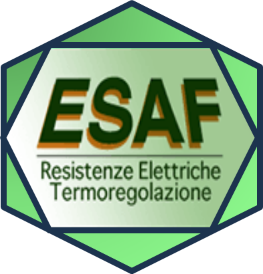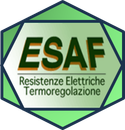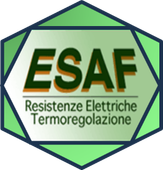INDUSTRIAL INFRARED HEATERS
Infrared heaters for heating and industrial processes. High power, efficiency, and energy saving.
Infrared heaters are a system widely used for heating domestic and industrial environments. The main advantages of infrared heaters are their efficiency, with low consumption and significant energy saving, and rapid, precise heating action.
The Advantages
- Low consumption (2500W - 6000W)
- Heats the room in seconds
- Up to 50 m2 heated indoors
- Does not stir up dust
SUPPLY OF INDUSTRIAL INFRARED LAMPS
ESAF supplies
infrared heating lamps and panels for industrial use, ideal for large production areas such as workshops, warehouses, or work centres.
THE ADVANTAGES OF INDUSTRIAL INFRARED HEATING
Infrared heating for industrial environments offers many advantages, both economically and practically. The heating action of infrared rays does not disturb the air, which prevents the displacement of dust or particles commonly present in workshops, warehouses, and other large spaces. This feature also helps to avoid the formation of mould, as it does not generate moisture within the environments.
Infrared lamps, depending on their wavelength characteristics and power, are suitable for various industrial applications, whether for uniform heating of large areas (up to 50 square metres with a single lamp) or for single stations where localised heating is needed.
Modern infrared heaters are designed to keep consumption low, allowing significant savings on energy costs for heating.
TYPES OF INDUSTRIAL INFRARED HEATERS
The models of infrared heaters differ mainly in the wavelength emitted, which determines the heating speed of the environment and the ability to heat spaces of varying sizes and the distances required for installation.
Infrared heaters are distinguished by three types of waves: short, medium, and long.
SHORT WAVE INFRARED LAMPS
Short wave infrared heaters in industrial environments are ideal for rapid and superficial heating of large buildings with high ceilings.
Halogen elements develop temperatures up to 1200°C. Short wave industrial heaters must be installed at a proper distance from objects and people, with a minimum distance of 5 metres.
Perfect for industrial areas up to 50 square metres.
Given their high operating temperature, short wave heaters are often used in industrial production, such as in the thermal treatment of plastics or for the drying and curing of paints.
MEDIUM WAVE INFRARED LAMPS
Medium wave infrared lamps provide slower but more uniform heating of large spaces. The infrared rays maintain excellent thermal performance and have an operating temperature of 500/600°C, ensuring a longer lifespan compared to short wave lamps.
The low light emission prevents bothersome reflections or excessive light.
Suitable for industrial environments up to 30/35 square metres when used individually.
LONG WAVE INDUSTRIAL HEATERS
Long wave industrial infrared heaters have the highest capacity for transmitting heat to objects and people, making them the most suitable for comfort. The main advantage is that they do not emit visible waves (which could be harmful to skin and eyes) and can therefore be placed at a shorter distance from people.
The operating temperature is around 300°C, ensuring a longer lifespan for the lamp.
Ideal for single stations or in combination with other lamps for large environments.
USES OF INFRARED HEATERS
Infrared heating systems, as seen, can have various characteristics and temperature levels, adapting to different application contexts and industrial uses.
Heating Environments:
- Large spaces, factories, warehouses, and industrial structures
- Agricultural use, heating animals
Uses in the Production Sector:
- Cooking and heating of food during preparation and production
- Heating and melting of plastics
- Drying of paint
- Removal of moisture
INFRARED HEATERS IN INDUSTRIAL APPLICATIONS
Infrared rays are widely used as heating systems for industry and production sectors. Here are the main application contexts:
- Drying of paints, tiles, and two-component epoxy resins, polyesters, and acrylics
- Drying in the textile industry and shipyards
- Heating of workstations in environments where it is not possible or economical to use conventional heating systems
- Polymerisation and preparation for moulding in the plastics industry
- Bending and thermoforming of acrylic materials, PVC, nylon, and ABS plastics
- Open tunnels for drying automotive bodywork, machine tools, and metal furniture








